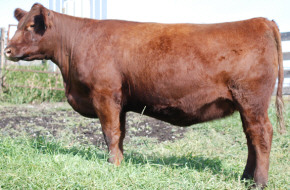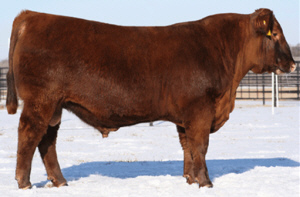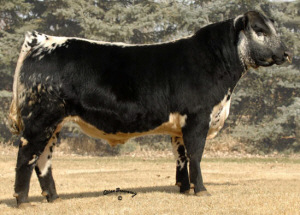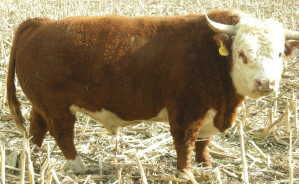



Red Angus
History
The Red Angus breed has the exact same origins of the Aberdeen Angus. Originally it was brought in by the Vikings from Europe and introduced to England and Scotland, these cattle were small, dun-coloured and polled.
 Photo courtesy of Crowfoot Cattle Company, www.crowfootcattle.com |
A breeder of Red Angus cattle, Eric L.C. Pentecost, explains a possible reason for the introduction of the red colouration into the Aberdeen Angus breed. In the eighteenth century, the black Scottish cattle were too light to provide sufficiently large draught oxen, so larger English longhorns, predominantly red in colour, were brought in and crossed with the black native polled breed. The resultant offspring were all black polled animals, since black is a dominant colour, and red a recessive one. However, all carried the red gene. Subsequent interbreeding produced an average of one red calf in four, in accordance with Mendel's law of heredity.
Early in the development of the Aberdeen Angus, Hugh Watson of Keillor, Scotland arbitrarily decided that black was the proper colour for the breed, and thereby started a fashion. He might well have chosen red instead. Leon J. Cole and Sara V. H. Jones of the University of Wisconsin Agricultural Experiment Station published a pamphlet in 1920 on "The Occurrence of Red Calves in Black Breeds of Cattle" which contained this pertinent paragraph:
"One more point should be emphasised, namely that the red individuals appearing in such stock (Aberdeen Angus)...are just as truly 'purebred' as their black relatives, and there is no reason why, in all respects save colour, they should not be fully as valuable. The fact that they are discarded while the blacks are retained is simply due to the turn of fortune that black rather than red became established fashion for the Aberdeen Angus breed. Had red been the chosen colour, there would never have been any trouble with the appearance of blacks as off-colour individuals, since red-to-red breeds true."
When the first Aberdeen Angus Herdbook was created in 1862 in Scotland, although black was the predominant colour reds were registered without discrimination. Angus was taken to America and increased in popularity, here in 1917 it was decided that to assure a pure black strain reds and other colours would not be allowed to register. This bias towards the black Angus inspired cattlemen who believed in the qualities of the red to start selecting the best red calves from the black Angus. In 1954 a new herdbook and Association specifically for the reds was started, Red Angus was launched in its own right.
Characteristics
The Red Angus is similar in conformation to the Aberdeen Angus, medium in size with a beefy carcase.
 Photo courtesy of SSS Red Angus Herd, www.sssredangus.ca |
Red Angus females reach puberty at a young age, are highly fertile and are renowned for their longevity in the herd. Red Angus females have excellent milk production and have a strong maternal instinct.
Red Angus cattle are considered by breeders to be gentle natured and easy cattle to work.
This breed produces a highly desired carcase with the meat being of excellent quality, this is due to the intra muscular marbling.
Statistics
Comparative
Distribution
Today, Red Angus are seeing unparalleled popularity both in the U.S. and internationally. In fact, the growing notoriety of the breed is bringing worldwide demand for breeding stock from South Africa, Australia and South America, where the majority of the cattle are red in colour. This has led Red Angus to become the leading U.S. beef breed in semen exports. In the U.S., the number of Red Angus has tripled from the mid-1980’s through the mid-1990’s. In Canada, where red and black Angus cattle are registered together (which is the case in most countries), the number of red cattle registered is approximately the same as the black strain.
 Photo courtesy of McMurphy Farms, www.mcmurphyfarms.com |
References (the above information was cited from the following sites)
redangus.org
www.redangus.org.au
www.sssredangus.ca
www.mcmurphyfarms.com
www.crowfootcattle.com


